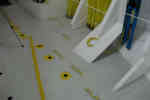Step 3 of 4•3 minutes read
Fixed Securing Equipment
Portable cargo securing equipment can be attached to different types of fixed securing equipment on board the vessel. In this section, examples of such equipment are presented.
Included in the fixed equipment is the wide range of lashing fittings that may be found on vessels. Some fittings may be designed to hold weak portable lashing equipment, such as car lashings, while others might be strong enough to support several heavy duty lashings. When portable and fixed cargo securing equipment is used together, the MSL for the combination should always be based on the weakest component.

Lashing holes and crinkle bars
Lashing Holes
Some vessels are equipped with lashing holes, typically intended for securing of light vehicles by the use of car lashings.

Lashing holes
Sockets
On vessels intended for carrying heavy RoRo cargoes, raised or flushed lashing sockets may be installed into the deck. The sockets are primarily designed for facilitating the elephant feet hooks. The MSL of lashing sockets is typically 10 tons (100 kN) and they may hold more than one lashing.

Lashing sockets can be raised or flushed
Lashing Eyes (D-rings)
Raised or flushed D-ring fittings may be installed either on the deck or on bulkheads and they may consist of one or two lashing eyes. D-rings are available in various strengths.

D-rings, or lashing eyes, can be raised or flushed
Crinkle Bars and Lashing Chains
On some vessels, crinkle bars or links of chains may be welded to the deck and used as fixed lashing points.
Deck Socket for Container Twist Locks
On some vessels, deck sockets for container twist locks may be welded into the deck. Apart from twist locks, container sockets may also be utilised to hold other fittings such as lashing eyes.
Summary
There are various types of cargo securing equipment. The types that are used onboard a vessel depend on what kind of cargo the vessel normally loads. The various features of the equipment and individual aspects of the cargo securing material are also decisive when a shipping company or a vessel decides what type of equipment to use. The strength of the lashing equipment is found on the certificate that is accompanied by the manufacturer when it is bought. The certificate shall have information on the loads the equipment has been tested for, usually expressed in MBL (Minimum Break Load) and/or MSL (Minimum Securing Load) which is the highest load to which cargo securing equipment may safely be subjected. For example, MSL is 50% of MBL for web and chain lashings at sea transports.
Sometimes this information may be found on a marking label or tag that usually is stuck to web lashings. When it comes to chain lashings, this information may be determined if you know the diameter of the chain.